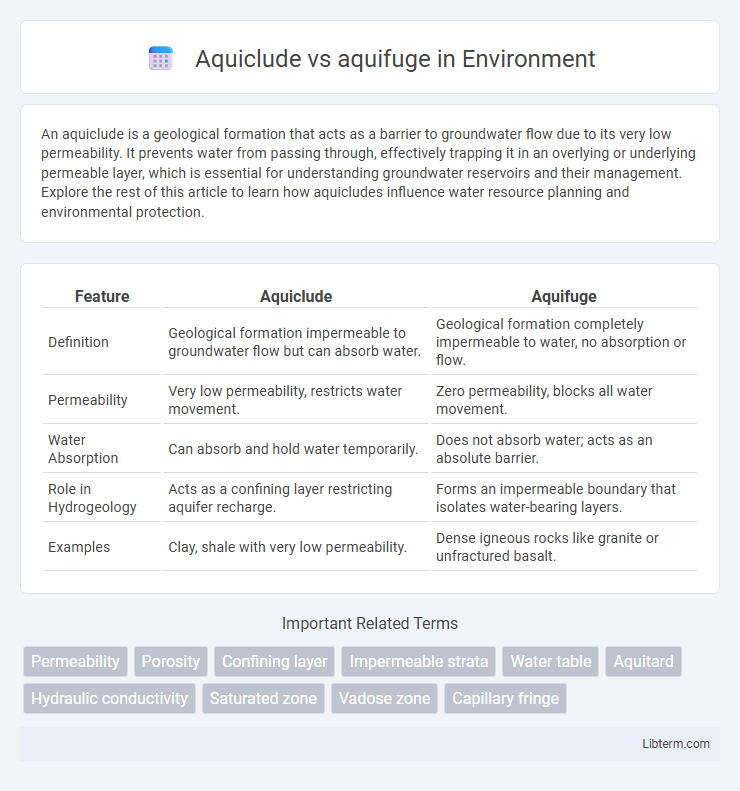An aquiclude is a geological formation that acts as a barrier to groundwater flow due to its very low permeability. It prevents water from passing through, effectively trapping it in an overlying or underlying permeable layer, which is essential for understanding groundwater reservoirs and their management. Explore the rest of this article to learn how aquicludes influence water resource planning and environmental protection.
Table of Comparison
| Feature | Aquiclude | Aquifuge |
|---|---|---|
| Definition | Geological formation impermeable to groundwater flow but can absorb water. | Geological formation completely impermeable to water, no absorption or flow. |
| Permeability | Very low permeability, restricts water movement. | Zero permeability, blocks all water movement. |
| Water Absorption | Can absorb and hold water temporarily. | Does not absorb water; acts as an absolute barrier. |
| Role in Hydrogeology | Acts as a confining layer restricting aquifer recharge. | Forms an impermeable boundary that isolates water-bearing layers. |
| Examples | Clay, shale with very low permeability. | Dense igneous rocks like granite or unfractured basalt. |
Introduction to Groundwater Barriers
Aquicludes and aquifuges are critical groundwater barriers distinguished by their permeability characteristics; aquicludes allow minimal water passage due to very low permeability, whereas aquifuges are completely impermeable, blocking any water flow. These geological formations influence groundwater movement and accumulation, impacting aquifer recharge and confinement. Understanding the properties of aquicludes and aquifuges is essential for effective water resource management and groundwater contamination prevention.
Defining Aquiclude: Features and Functions
An aquiclude is a geological formation characterized by its impermeable properties, preventing the flow of groundwater due to extremely low porosity and permeability. It functions as a natural barrier that confines aquifers, thus playing a crucial role in groundwater management by restricting water movement. Unlike an aquifuge, which is completely impermeable and neither stores nor transmits water, an aquiclude may hold limited water but effectively obstructs significant water flow.
What is an Aquifuge? Characteristics Explained
An aquifuge is a geological formation that is completely impermeable to water, preventing any movement or storage of groundwater. Unlike aquicludes, which may have very low permeability and can store water but prevent its flow, aquifuges halt both water movement and accumulation due to their dense, non-porous nature. Common examples include solid rock types such as granite or unfractured shale that serve as natural barriers in hydrogeology.
Key Differences Between Aquiclude and Aquifuge
Aquicludes are geological formations that allow some water to pass through very slowly due to their low permeability, whereas aquifuges are impermeable layers that completely block the flow of groundwater. Aquicludes often act as confining layers restricting water movement but do not wholly prevent it, while aquifuges serve as absolute barriers to water infiltration. Understanding the permeability and water transmission capacity is essential to differentiate between these two hydrogeological entities.
Geological Formations Acting as Aquicludes
Geological formations acting as aquicludes consist of dense, impermeable rock layers such as shale or unfractured clay that prevent water flow between aquifers. These formations effectively trap groundwater by blocking vertical or horizontal movement, maintaining distinct water zones. Unlike aquifuges, which are totally impermeable and contain no water, aquicludes may contain water but restrict its movement due to low permeability.
Common Types of Aquifuges in Nature
Common types of aquifuges in nature include clay, shale, and unfractured granite, which act as impermeable barriers preventing groundwater flow. These geological formations have extremely low porosity and permeability, making them effective in confining aquifers and creating hydrogeological boundaries. Understanding the distribution and characteristics of aquifuges is critical for groundwater management and contamination prevention.
Importance in Hydrogeology and Water Management
Aquicludes and aquifuges play critical roles in hydrogeology by controlling groundwater flow and storage; aquicludes are low-permeability layers that can store water but restrict flow, while aquifuges are impermeable rock formations that completely block water movement. Understanding the distinction between these geological features is essential for effective groundwater resource management, influencing well placement, contamination risk assessment, and sustainable water extraction. Accurate identification of aquicludes and aquifuges aids in groundwater modeling and informs infrastructure development, ensuring efficient water supply and protection of aquifers.
Aquiclude and Aquifuge: Role in Aquifers
Aquicludes and aquifuges are geological formations impacting groundwater flow within aquifers, with aquicludes acting as impermeable layers that restrict water movement and confine aquifers, thereby influencing groundwater storage and distribution. Aquicludes consist of materials like clay or shale, which have extremely low permeability, preventing water from passing through and effectively separating different aquifers or confining water within an aquifer. Aquifuges, by contrast, are completely impermeable rock formations that neither transmit nor store groundwater, serving as barriers that define the boundaries of aquifers and limit groundwater recharge and flow patterns.
Practical Applications and Engineering Considerations
Aquicludes, characterized by low permeability but potential for small water transmission, are used in groundwater management to confine aquifers and prevent lateral flow, making them suitable for constructing barriers in wellfields and contamination control zones. Aquifuges, being impermeable and completely preventing water movement, serve as critical natural seals in hydrogeological engineering and foundation design, ensuring stability and isolation of water-bearing formations. Engineers must assess material permeability and structural integrity when selecting aquicludes or aquifuges for projects like dam construction, landfill liners, and subsurface water isolation to optimize groundwater resource management and infrastructure safety.
Summary: Selecting Between Aquiclude and Aquifuge
Aquicludes are geological formations that allow minimal water flow due to their low permeability, making them effective barriers but not completely impermeable. Aquifuges, on the other hand, are completely impermeable layers that prevent any water movement, serving as absolute confining units in hydrogeology. Selecting between an aquiclude and an aquifuge depends on the required degree of water flow restriction in groundwater management, with aquifuges used for total confinement and aquicludes for partial retardation.
Aquiclude Infographic

 libterm.com
libterm.com